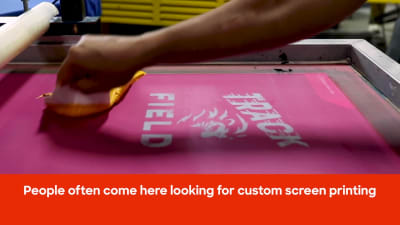Professional Screen Printing Kit for Custom Apparel
Professional Screen Printing Kit for Custom Apparel
Blog Article
Display Printing Uncovered: Every Little Thing You Need to Understand About Tee Shirt and Garment Printing Strategies
If you've ever questioned exactly how those vivid layouts finish up on your favored tees, you're in the right place. Screen printing is a remarkable method that combines art with method, offering unlimited opportunities for creativity. Comprehending the basics, from tools to ink options, can substantially affect your outcomes. Prepared to explore the important elements that make screen publishing an art form? Let's uncover the information that can elevate your jobs.
The Fundamentals of Screen Printing: Just How It Works
When you plunge into screen printing, you'll find it's both an art and a scientific research. At its core, display printing entails creating a pattern, or screen, that permits ink to pass with only in details locations (screen printing kit). You start by selecting your style and preparing your screen with a light-sensitive emulsion. Once you reveal this solution to light, it solidifies, leaving your layout as an unfavorable space.
Next, you'll mix your inks and prepare your printing surface. Position the display over the fabric, then make use of a squeegee to push ink with the screen onto the garment. This procedure requires accuracy, as you want clear, dynamic prints. After printing, you'll treat the ink with warm, guaranteeing it follows the textile and lasts through washes. Each action is necessary, and mastering them will boost your display printing skills, transforming straightforward garments into unique, meaningful items.
Sorts Of Screen Printing Methods
As soon as you grasp the essentials of screen printing, it's time to check out the different strategies that can raise your layouts. One prominent approach is typical display printing, where ink is pushed via a stenciled display. This method is excellent for strong, vibrant colors. After that there's water-based ink printing, which offers a softer feeling and is environment-friendly, but it needs a different method to curing.
If you're going for great details, think about discharge printing. This method eliminates color from the material, leaving a soft, classic look. An additional alternative is plastisol printing, understood for its resilience and vivid colors, making it a preferred for several brand names. Experiment with halftone printing to create gradient effects and complex layouts. Each technique has its one-of-a-kind appeal, so don't wait to try them bent on discover what suits your style best!
Vital Equipment for Display Printing
To achieve sensational lead to screen printing, having the appropriate devices is basic. First, you'll require a durable display printing frame, which holds the mesh that transfers your layout onto the garment. Next off, purchase high-quality squeegees; these are essential for applying ink uniformly throughout the screen. You'll likewise need an excellent exposure device to produce your displays, as well as a washout cubicle for cleaning them after usage. A reliable warmth resource, like a conveyor clothes dryer or warm press, is critical for treating your prints to assure long life. Do not fail to remember a proper workspace, equipped with tables and storage for your products. Finally, safety gear, such as handwear covers and masks, will certainly keep you risk-free from chemicals and inks. With the right tools, you'll be well on your way to creating professional-quality prints.
Selecting the Right Inks and Materials
When choosing inks and materials for screen printing, you need to think about the type of ink that functions ideal for your project. Think about textile compatibility to assure your styles look wonderful and last lengthy. Discover environment-friendly ink choices to make your printing process more lasting.
Kinds Of Screen Inks
Selecting the right screen ink is vital for accomplishing dynamic, resilient prints that meet your job's demands. There are several types of screen inks to examine. Specialty inks, such as metallic or glow-in-the-dark, can include special effects to your layouts.

Material Compatibility Factors To Consider
Understanding material compatibility is vital for attaining high-quality display prints, particularly because different materials react distinctly to various inks. Constantly check your inks on example fabric to guarantee they adhere effectively and maintain color stability. In addition, keep in mind that material weight and texture can impact the last result, so picking the best ink and product combo is important for your project's success.
Eco-Friendly Ink Options
Environment-friendly inks are coming to be a prominent option for screen printers that intend to reduce their ecological influence while maintaining high quality. When picking inks, think about water-based inks, which are much less damaging and simpler to tidy up contrasted to standard solvents. These inks bond well with fabrics, delivering vivid outcomes without poisonous chemicals. You might also check out eco-solvent inks that utilize less unpredictable organic compounds (VOCs), making them a more secure option for both your wellness and the planet.
In addition, seek inks made from renewable energies, such as soy or check here vegetable-based choices. By picking the ideal inks and materials, you'll not just develop stunning designs however additionally add to a more sustainable printing process. Make the switch, and your prints will show your commitment to the environment!
Preparing Your Layout for Display Printing

File Style Requirements
To guarantee your style looks lively and sharp on textile, you'll require to pay close interest to file format demands for screen printing. Make sure your design has a transparent background to avoid unwanted white edges on your prints. Keep shade settings in mind; CMYK is common for screen printing, so transform your RGB develops as necessary.
Color Splitting Up Methods
Color splitting up is a vital action in preparing your design for screen printing, and mastering it can greatly enhance your print high quality. You'll require to break your layout into specific colors, as each color calls for a separate display during printing. Beginning by identifying all the colors in your style and create layers each. You can make use of software program like Adobe Photoshop or Illustrator to separate and different shades properly. Be certain to save each layer as he said a different documents, usually in a style like TIFF or PSD. This accuracy not only guarantees accurate shade representation yet also improves the printing process. By focusing on color separation, you'll accomplish dynamic and specialist cause your screen-printed garments.
Resolution and Dimension
Attaining the most effective lead to screen printing starts with assuring your style has the appropriate resolution and size. Preferably, your art work ought to go to least 300 DPI (dots per inch) for sharp, clear prints. Your last product may look pixelated and unprofessional. if you use reduced resolution.
When it pertains to dimension, think about the measurements of your print location. Layout your art work to match the last print dimension, ideally creating it in the actual measurements you'll be printing. This means, you'll stay clear of any type of unanticipated scaling concerns.
Constantly check your design in both vector and raster layouts. Vector graphics can be scaled without losing top quality, making them suitable for screen printing. Preparing properly will guarantee your style looks remarkable on every garment!
Step-by-Step Display Printing Refine
Display printing is a dynamic process that allows you to create vivid designs on different surfaces. To begin, you'll need a display, emulsion, and your selected ink. Initially, prepare your display by cleansing it extensively. Next, apply the emulsion uniformly and let it completely dry in a dark location. When completely dry, expose your display to light with your design positioned on it, which will set the solution where the light hits, producing a stencil - screen printing kit.
Put ink onto the screen and utilize a squeegee to press the ink through the pattern onto the fabric. Lift the display thoroughly and allow the print completely dry. You've successfully screen published your layout.
Tips for Effective Display Printing Projects
While you're diving into your screen printing tasks, bear in mind that preparation is vital to success. Begin by collecting all your materials-- inks, displays, squeegees, and garments. A clean work area aids protect against undesirable mistakes, so clean prior to you begin.
Next, validate your art work is high-resolution and properly sized for your garment. Check your screen for appropriate direct exposure and clean it extensively to prevent spots. When mixing your inks, comply with the manufacturer's guidelines to attain the best uniformity.
Throughout printing, apply even pressure with your squeegee you could look here for constant outcomes. Don't rush; take your time to validate each print meets your requirements. After printing, allow your garments dry totally prior to dealing with or packaging them.
Last but not least, constantly keep a sample of your job for future reference. By doing this, you can assess your development and boost your techniques gradually. Delighted printing!

Regularly Asked Questions
How much time Does It Require To Establish up a Screen Printing Task?
Establishing up a screen printing work usually takes about thirty minutes to an hour. You'll prepare the screens, mix inks, and adjust journalism. The moment varies based on complexity and experience, so stay organized!
Can I Print on Different Material Enters Utilizing the Exact Same Strategy?
Yes, you can print on different material types using the exact same technique, however you'll require to adjust your setups and inks. Some textiles take in ink differently, so trying out guarantees the most effective outcomes for each product.
What Prevail Blunders to Prevent in Display Printing?
When screen printing, prevent usual mistakes like using the wrong ink, overlooking appropriate direct exposure times, or skipping pre-press checks. Constantly evaluate your arrangement and maintain clean screens to assure quality results each time.
Just How Can I Effectively Clean and Maintain My Screen Printing Equipment?
To appropriately tidy and preserve your screen printing equipment, you must regularly wash screens with ideal solvents, examine squeegees for wear, and ensure all tools are kept dry and dust-free. Consistency stops expensive repair services and boosts efficiency.
Is Screen Printing Eco-friendly Contrasted to Various Other Approaches?
Display printing can be extra eco-friendly than various other methods, especially if you make use of eco-conscious materials and water-based inks. By choosing lasting supplies and practices, you reduce waste and lessen your effect on the world.
Display Printing Uncovered: Every Little Thing You Need to Know Concerning Tee and Garment Printing Methods
At its core, screen printing involves creating a pattern, or screen, that permits ink to pass with just in certain locations. Placement the screen over the textile, after that use a squeegee to push ink through the screen onto the garment. One prominent method is typical screen printing, where ink is pressed with a stenciled screen.When selecting inks and materials for screen printing, you need to take into account the kind of ink that works ideal for your job.
Report this page